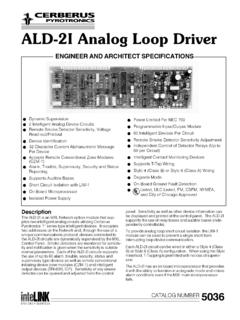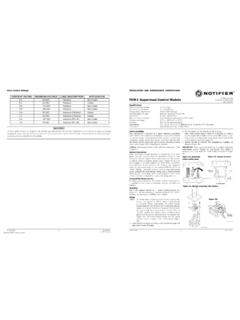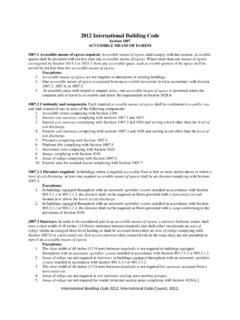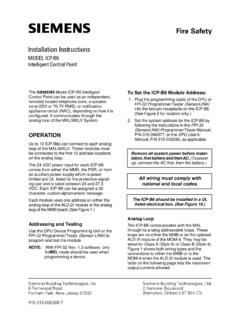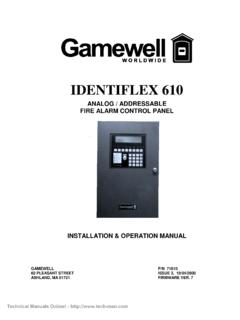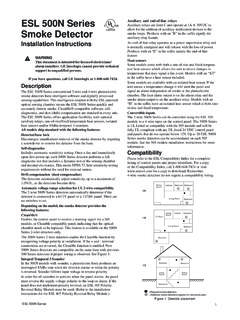Transcription of Installation Instructions Model HFP-11 / HFPT-11
1 Installation Instructions Model HFP-11 / HFPT-11 . FirePrint Detector / FirePrint Thermal Detector Figure 1. HFP-11 and HFPT-11 . These Instructions are written in accordance with the installa- an excess level of smoke or aerosol for an extended period of tion guidelines of NFPA 72, National Fire Alarm Code, and time, the detector is programmed to make the safe deci- CAN/ULC-S524, The Installation of Fire Alarm Systems. sion and signal an alarm condition. Because the amplitude and duration of deceptive phenomena are unbounded, the rule of thumb is to keep detectors as far as practical from Detector Device Storage sources that can produce an unusually large quantity of smoke for about a minute.
2 This effort during placement of detectors DO NOT install this detection device until all construc- within a FirePrint Application enhances the ability of FirePrint's tion is completed. deceptive phenomena rejection. Avoid close proximity of de- tectors to smoke sources such as oil burners, electric heat- DO NOT store this detection device where it can be con- ers, kitchens, garages, and areas of high relative humidity taminated by dirt, dust, or humidity. where condensation may occur. Air Currents HFP-11 DETECTOR PLACEMENT. Before a detector can sense a fire, the products of combustion Although no specific spacings are set for the detectors used or smoke must travel from the fire to the detector.
3 This travel for a clean air application, use 30 foot center spacing (900 sq ft) is especially influenced by air currents; therefore, consider air from NFPA Standard 72 and CAN/ULC-S524, if practical, as a movement when designing the system. While combustion guide or starting point for a detector Installation layout. This products tend to rise, drafts from hallways, air diffusers, fans, spacing, however, is based on ideal conditions smooth ceil- etc., may help or hinder the travel of combustion products to ing, no air movement, and no physical obstructions.
4 In some the detector. When positioning a detector at a particular loca- applications, therefore, considerably less area is protected ad- tion, give consideration to windows and doors, both open equately by each smoke detector. This is why it is mandatory and closed, to ventilating systems, both in and out of opera- to closely follow the Installation drawings. In all installations tion, and to other factors influencing air movement. Do not place the detector on the ceiling, a minimum of 6 inches from install a detector in the air stream of a room air supply dif- a side wall, or on a wall, 4 to 6 inches from the ceiling.
5 Fuser. It is better to position a detector closer to an air return. If you have any questions regarding detector placement, fol- The distance that products of combustion or smoke travel low the drawings provided or approved by Siemens Building from a fire to the detector is not usually the shortest linear Technologies, Inc. or by its authorized distributors. This is ex- route. Combustion products or smoke usually rise to the ceil- tremely important! The detector placements shown on these ing, then spread out. Average ceiling heights of 8 to 10 feet drawings were chosen after a careful evaluation of the area do not abnormally affect detector response.
6 High ceilings, lo- that is protected. Such factors as air currents, temperature, cated in churches, warehouses, auditoriums, etc., do affect humidity, pressure, and the nature of the fire load were care- detector response and should be considered. fully considered. Especially noted were the room or area con- figuration and the type of ceiling (sloped or flat, smooth or Special Ceiling Construction Factors beamed). Siemens Building Technologies, Inc.'s extensive ex- Ceiling obstructions change the natural movement of air and perience in the design of the system assures the best detec- combustion products.
7 Depending on the direction of smoke tor placement by following these drawings. Sound engineer- travel, joists and beams can slow the movement of heated air ing judgment by qualified personnel must be followed. and smoke, while pockets between them can contain a re- duced level of smoke. Take obstructions created by girders, Fire Print detectors And Nuisance Alarms joists, beams, air conditioning ducts, or architectural design into The neural network within each SIEMENS Model HFP-11 consideration when determining area protection. Refer to the FirePrint detector is optimized to reject the most common Initiating Devices chapter of NFPA Standard 72 for Location nuisance alarms for its selected FirePrint Application; and Spacing requirements for specific types of construction.
8 Parking Garage or Health Care. If the detector is exposed to beam, suspended, level, sloped and peaked ceilings. P/N 315-033290-5 Siemens Building Technologies echnologies Fire Safety Safety HFPT-11 DETECTOR PLACEMENT That its smoke sensitivity is within the range indi- cated on the nameplate label Locate SIEMENS Model HFPT-11 on the ceiling, at least 4 inches That its critical smoke sensing electronics are from the side walls. For an ideal, smooth ceiling condition, place operating. the detectors at a maximum center spacing of 50 feet (2500.)
9 Based on the results of these checks, the LED indicator flashes square feet), 25 feet from side walls or room partitions. the following: Actual job conditions and sound engineering judgment must Flash Interval determine detector spacing. Consider environmental factors (Seconds). Flash including ambient temperature fluctuation, and the nature of Color Condition HFP-11 . the fire hazard. Room or area configuration and ceiling type Normal supervisory (sloped or flat, smooth or beamed) also dictates placement. Green* operation. Smoke sensitivity 4.
10 Is within rated limits. Should questions arise regarding detector placement, follow Detector requires service the drawings provided and/or approved by Siemens Building (cleaning or repair) or is Yellow 4. Technologies, Inc. or by its authorized distributors. This is ex- operating beyond its environmental specifications. tremely important! The detector placements shown on these drawings were chosen after a careful evaluation of the area Red Alarm 4. being protected. Siemens Building Technologies, Inc.'s exten- No Flashes Detector is not powered, or - sive experience in design of the system assures the best requires repair.

